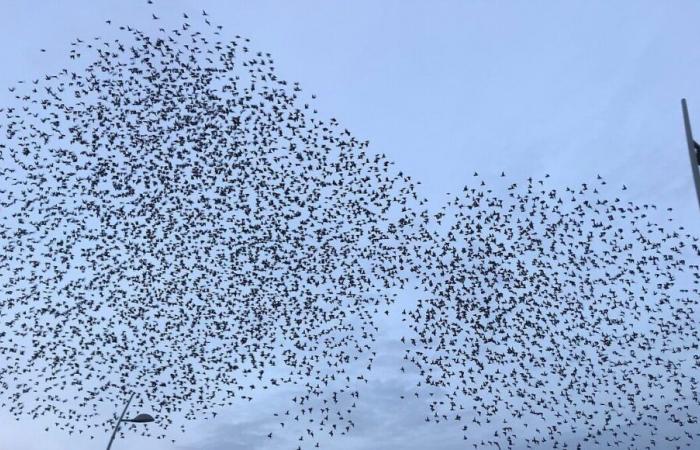The mast stands below the Allée du Docteur Pouliquen in Landerneau in northern Finistère, a few meters from the Elorn, on the promenade popular with joggers, walkers and their dogs. Flanked by a gas bottle and funny orange-brown rubber straps, the gas cannon is protected by a padlocked barrier. It has just been installed by Maël Péden, general delegate of the Departmental Federation of Groups for the Defense of Pests (FGDON), to scare away starlings. “We have a gas cannon here which is equipped with a clock with a microprocessor, this allows the shots to be triggered randomly. That is to say, the birds cannot predict the arrival of the next shot since it is the processor that decides to program, to have one to three shots every four to 10 minutes. The frequency is high enough to remind them when they want to land, but not high enough for them to land. 'they can predict the next shot. This gas cannon is topped by an aluminum mast which is seven meters high and along which, at each detonation, we have a circulation with what we call a decoy.' is simply rubber strips that rise with each detonation. Watch out!”
Detonation and raptor simulation
Be careful, because here comes the detonation, and the brown rubber straps which go up suddenly… and come down twirling. “The detonation, even us, it makes us jump. And the birds, it's the same. There is a surprise effect with the detonation and then, we have this lure movement which gives them a visual stimulus which awakens in them an ancestral fear of a raptor attack.” Which is much cheaper than a real bird of prey accompanied by its falconer master. The cannon operates between 5:30 p.m. and 7:30 p.m. when the birds are seeking shelter and in the morning from 7:30 a.m. to 9 a.m.
Aurélie Lagain
And it works. Because two years ago, “the ground was littered with droppings and which was extremely slippery”recalls Stéphane Clost, external manager at the City of Landerneau. “It was also unpleasant in terms of smells…” And again, we don't talk about the noise made by the hundreds of birds grouped together on the yew trees on the banks of the Elorn. Because here, there are not many local residents, but walkers. “It was really dirty, those bird droppings.”recalls Jacqueline who used to walk her dog here. “It’s not nice to walk on droppings!”
Do it in advance
So yes it works. “The birds have understood, notes Jacqueline, They go to other trees!” But you have to plan ahead, from the first birds that arrive as “scouts” and often in the same places as other years. The address is good, but the landlord is much less willing: “Birds have habits that are relatively routine and we know that from one year to the next, they will often try to re-occupy the sites they occupied in previous years”explains Maël Péden. “Here, they were for almost a whole winter, four or five years ago and we know that it will come back systematically, they will try to settle there. So, we anticipate. We know that from from October 20, between October 20 and November 1, you must be vigilant”. The first birds, “we hear them, and we see the first droppings on the trees and on the ground”explains Stéphane Clost, to the City.

Aurélie Lagain
Scare away starlings in the countryside
But obviously, the canon is only a warrior in name, there is no question of eradicating starling colonies. It's about scaring them away. And they could go elsewhere and not so far, return to the trees of the Saint-Houardon church, “There are large trees, cedars which are evergreen. They are more sheltered in these trees than in deciduous trees which are starting to lose their leaves and which present a less interesting refuge for them.” Then the cannon can be moved… or split.
Layers of droppings several tens of centimeters long
Objective of the City of Landerneau: make them go far away… to the countryside. “They go to a place where it poses fewer problems, to their nocturnal roosting site. But they continue to feed on agricultural plots or on livestock feeding sites, which poses a real problem for the agricultural world But as far as transit sites are concerned, we manage to locate them in places where it poses fewer problems for the public. In fact, here, it is a very small urban dormitory which will paradoxically generate a lot of nuisance compared to it. to a rural dormitory which we can consider to be of regional importance, where we will have several hundred thousand birds, the concentration is really important. We have quantities of droppings which are really of completely different measures. Or up to tens of centimeters of layers of droppings.

Aurélie Lagain









